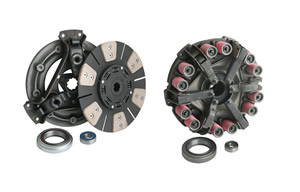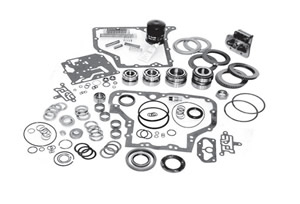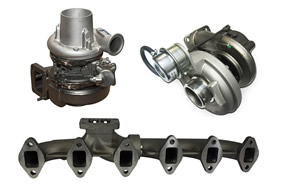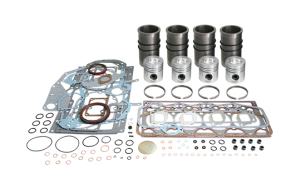 Fordson was the brand name of tractors and trucks mass-produced by the Henry Ford & Son Inc from 1917 to 1920, By Ford Motor Company USA and UK between 1920-1928 then by Ford Motor company UK from 1929 to 1964.
Fordson was the brand name of tractors and trucks mass-produced by the Henry Ford & Son Inc from 1917 to 1920, By Ford Motor Company USA and UK between 1920-1928 then by Ford Motor company UK from 1929 to 1964.
Between 1917 and 1922 the Fordson brand was for tractors somewhat like the Ford Model T was for cars. The brand was felt to have a reliable design with a low price affordable for both farmers and workers with support of a widespread dealership network and factory production capability to produce in large numbers.
Ford through the Fordson brand name dominated the market between 1917-1925. Fordson production occurred in the US, Dearborn, Michigan (1917-1928) in Cork in Ireland (1919-1923) and (1928-1933), and Dagenham, Essex England (1933-1964). In the first forty years of production between 1917 and 1957 over 2.5 million tractors were produced.
Fordson Model F
The first production tractor was the Fordson Model F, the tractor used a 20 HP in-line four cylinder engine similar to the Model T, like many engines of its day it was multi-fuel capable, it was usually tuned for gasoline or kerosene, but alcohol could also be burned (tractor vaporising oil (TVO) existed in 1920 but was not widely used until 1930s and 1940s).
Fordson N Standard
The Fordson Model N replaced the Model F staring production in Cork in 1927 until it was transferred to Dagenham in 1933. The Model N featured a 27HP engine, during the world war the Dagenham plant produced over 136,000 Model N tractors.
Ford 9N Model
The next important innovation – one of the most important in the history of the tractor – was the introduction of the three-point system in the late 1930s. it was to be introduced on Ford’s 9N model, having been designed by Harry Ferguson, and is still used on Farm tractors today. This ingenious system, combined with a variety of compatible three-point implements, made the tractor a viable replacement for the horse and horse-drawn implements.
The Model 9N was first demonstrated in Dearborn, Michigan, on 29 June 1939. The new agricultural concept revolutionised farming. The basic design principles and features incorporated into the 9N are still evident in many of the tractors currently being manufactured. The Ford 9N, the first of the N Series tractors went on sale complete with the first three-point hitch in 1939. It was developed as a versatile all-purpose tractor for the small farm and was exceedingly popular. The 9N was powered by an in-line four-cylinder 1966cc/120cu in displacement gasoline engine. Many of the engine’s internal components, including the pistons, were compatible with parts used in Ford’s V8 automobile of the time.
Ford 2N Model
The 9N went through subtle changes during each year of its three-year production run. By the end of 1941 Ford had made so many changes, and had so many more ideas for changes, that the designation of the tractor was changed to the Ford 2N. There were over 99,000 9Ns produced from 1939 to 1942 and almost 200,000 2Ns produced between 1942 and 1947 in a relatively short production run.
Ford 8N Model
The Ford 2N eventually evolved into the Ford 8N, a model that officially started its production run in 1947 and was to last until 1952. 1947 was also the year that the much-vaunted handshake agreement on the three-point hitch came to an end. Ford and Ferguson failed to reach an agreement when they tried to renegotiate their deal in the immediate post-war years. Ford declared he would continue using the hitch, but would no longer give Harry Ferguson any money for doing so, nor would he continue to call it the “Ferguson System”. As few official business documents existed this resulted in a lawsuit which eventually awarded Harry Ferguson approximately $10 million.
By the time the lengthy lawsuit was finally settled, however, some of the Ferguson patents had expired, enabling Ford to continue production of a hydraulic three-point hitch with only minimal charges. Ferguson then started producing the TE20 and TO20 tractors, in Britain and America respectively that were similar in appearance to the 8N and effectively competed with it.
A completely new line of implements was introduced by Ford. Some of the noticeable differences between the 8N and 2N tractors were the change in wheel nuts from six to eight in the rear wheels, a scripted Ford logo on the fenders and sides of the bonnet and finally, the absence of the Ferguson System logo which was no longer displayed under the ford oval even though the tractor still used Ferguson’s three-point hitch.
E27N Model
The Fordson E27N Major was based on the Fordson N and made in England from 1945. Ford’s new post-war tractor made in Dagenham was the Fordson E27N. It was rushed into production at the request of the British Ministry of Agriculture. The basis of the machine was an upgraded Fordson N engine with a three forward, one reverse gearbox, a conventional clutch and rear axil drive. The Fordson E27N started rolling off the Dagenham production line in March 1945. Ford had made numerous improvements to this tractor over its earlier model. The new tractor featured a spiral bevel and conventional differential instead of a worm drive and a single-plate wet clutch was incorporated. The E27N was powered by an in-line four-cylinder side-valve engine that produced 30hp at 1450rpm. It came in four versions, each with different specifications for brakes, tyres and gear ratios.
A variant using the Perkins P6(TA) engine was offered in 1948 giving the tractor 45HP power unit, the Perkins Diesel engine was particularly popular when compared to the under-powered petrol/TVO engine, the tractor fitted with the P6 engine was a popular machine with Australian Farmers .and in that year over 50,000 E27Ns were made. Production continued until 1951, with various upgrades and options being made available.
E1A Model ‘New Major’
In 1953, The E1A entered production with an all new engine, the 4D engine was designed and developed in UK at Dagenham and was available as diesel, gasoline, or kerosene. The driver sat significantly lower which led to the E27N being nicknamed the ‘High Major’. In 1958, The Power Major was introduced with 51.8 HP and improved transmission and ‘live-drive’ hydraulics and then in 1960 the final version the Super Major came out and was produced until 1964.
Dexta / Super Dexta Models
Meanwhile in 1958 a smaller new three-cylinder version was named Dexta and was launched to compete with the Massey Ferguson 35, of which it shared the basic engine, gearbox and differential castings as well as many other parts. Both tractors featured the Perkins A3 engine with a few differences. The engine was 144 cubic inches whereas later machines Super Dexta and all MF35’s had a 135 cid versions.
NAA Jubilee Model
Fords 50th anniversary was in 1953 and it introduced the NAA Jubilee model with Fords first overhead-valve engine, it had a displacement of 2195cc/134 cu in and produced 31 HP. In 1958 Ford introduced the 600 and 800 series tractors powered by US manufactured diesel engines although LPG and Gasoline versions were also offered. Subsequent models included Powermaster/Workmaster. The Model 8000 was the first Ford tractor to have a 100 HP engine displacing 6571cc/401 cu in whilst the smaller displacement Model 6000 produced 66HP.
Consolidation
During 1961 the US tractor operations and the UK tractor operations were reorganised for closer integration and after 1964 all tractor produced carried the Ford name. In 1986 Ford expanded its tractor business when it purchased Sperry-New Holland who specialised in skid steer loaders and hay balers, the newly consolidated business was called Ford New Holland which also acquired Versatile Tractors in 1988.
Ford Tractor production was carried out on a global scale with up to eight manufacturing plants around the world including Basildon UK, Romeo USA, Curitiba Brazil, India, Mexico & Belgium.
The Basildon factory was the highest producer of tractors for Ford worldwide and most famous for its 10 Series tractors. The 10 tractor range spanned for the 44hp 2910 to the 115hp 8210. The most popular 100hp 7810 tractor was produced in a special silver livery to celebrate the Queen’s Jubilee in 1990. Only a small number of tractors were built and now they have become very desirable.
In 1991 the Fiat Company acquired Ford New Holland Inc and merged it with Fiat Geotech renaming the company NH GeoTech. The 40 Series was first introduced in 1992 to replace the 10 Series and was produced right up to 1998 in Basildon. The 35 Series was seen a few years later replacing the smaller models in the range, and the larger 770 series appeared as well. The Versatile Farm Equipment Company became part of the Ford New Holland Americas and NG GeoTech changed its name to New Holland Inc in 1993. The Ford name was used up to 2001, when the tractors became known as New Holland.
Here at Engine Fix UK we cover the vast majority of the Fordson and Ford Tractor Model range, we supply all the major mechanical engine parts including pistons, piston rings, liners, gaskets, crank seals, gasket sets, valve train parts, water oil and fuel pumps plus much more.







 Just Template IT
Just Template IT